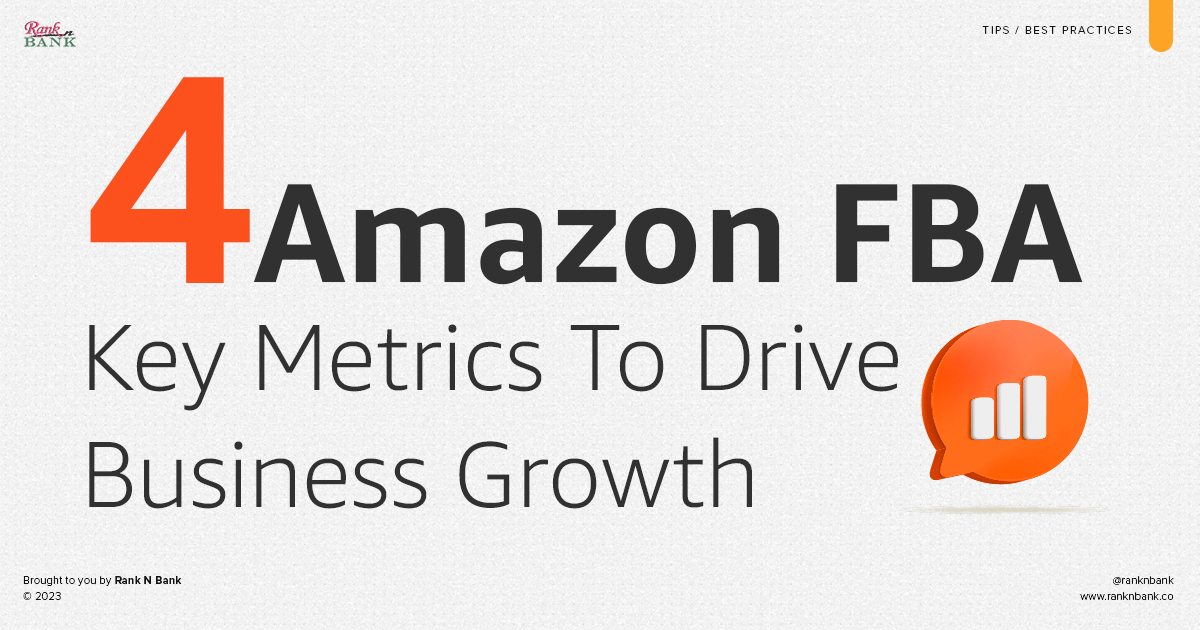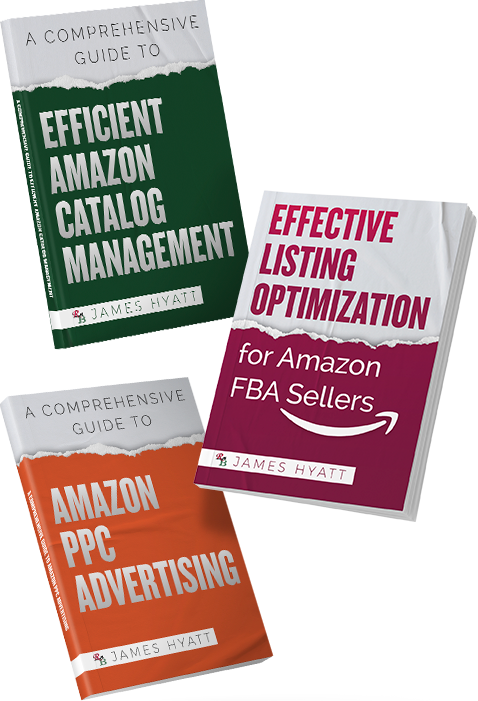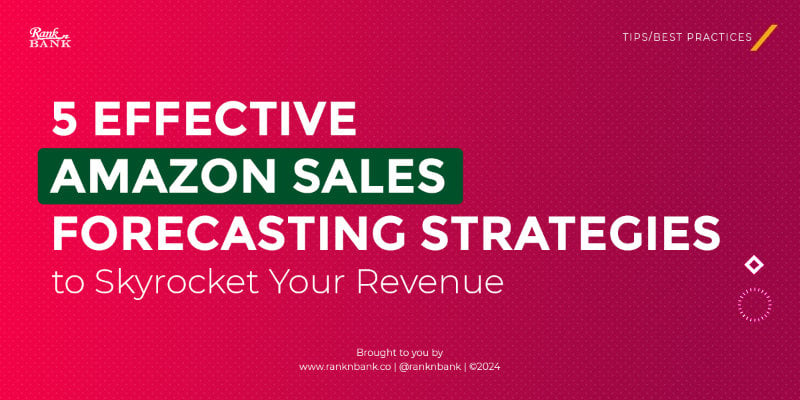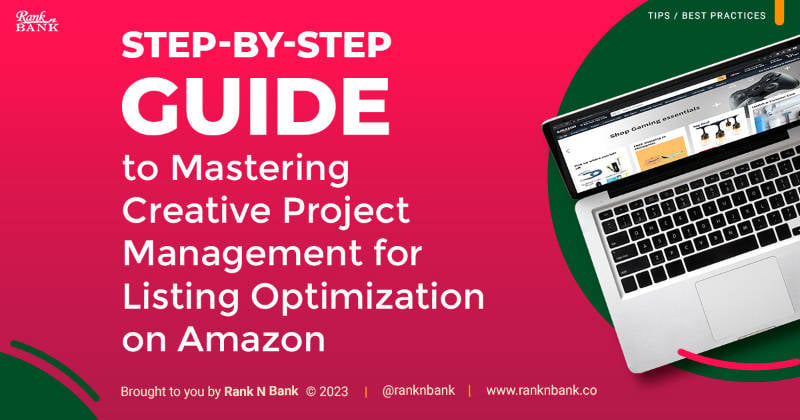Amazon has completely transformed the world of e-commerce, offering a platform for entrepreneurs, both big and small, to sell their products globally. However, just creating a store on Amazon doesn't guarantee success. To truly make it a success, you need to take advantage of Amazon's FBA program.
But enrolling in the FBA program isn't enough to succeed. You need to understand and analyze the key FBA metrics. By doing so, you can identify areas that need improvement, develop strategies for growth, and ultimately, take your business to the next level on Amazon.
Let’s dive into key FBA metrics, strategies for using them to drive growth, and best practices for FBA metric analysis.
What Are the Key Amazon FBA Metrics?
Amazon FBA metrics are key performance indicators (KPIs) that measure the health and success of your business on Amazon's marketplace. These metrics provide valuable insights into your sales, inventory management, customer satisfaction, and order fulfillment processes.

There are several key Amazon FBA metrics sellers should monitor and analyze to measure the success of their business on Amazon's marketplace.
These metrics can be broadly categorized into four main areas:
- Sales Metrics

You need to track sales metrics if you're an Amazon seller with many amazing products but are unsure how well they're doing. By tracking key indicators like revenue, units sold, and average order value (AOV), you get a pulse on your business’ health and can identify opportunities for growth.
Revenue: It’s the ultimate metric, measuring the money your business generates from sales on Amazon. Every seller dreams of watching their revenue grow over time, and by tracking this metric, you'll see the impact of your hard work pay off.
Units Sold: This is another critical metric to keep an eye on. It tells you how many products you've sold on Amazon, helping you determine which products are popular and in demand among customers. Use this information to decide which products to stock up on and which to let go of.
Average Order Value (AOV): It’s a great metric to track if you're looking to increase your revenue. A higher AOV means that customers are buying more products per order, so it's worth exploring ways to encourage them to do so. Maybe you could offer discounts on bundled products or use cross-selling and upselling techniques to encourage customers to add more items to their carts.
- Inventory Metrics

As an Amazon seller, keeping track of your inventory is crucial to ensure you can fulfill customer orders quickly and efficiently. You can make informed decisions about your inventory management strategy by monitoring key indicators like inventory levels, lead time, and sell-through rate.
Inventory Levels are all about finding the right balance. You want to ensure you have enough inventory in Amazon's warehouses to meet customer demand but not so much that it eats up all your capital or leads to additional storage fees. Keeping a close eye on this metric will help you optimize your inventory levels and keep your business running smoothly.
Lead Time is another critical metric to track. It's the time it takes for your inventory to be restocked once it runs out. The shorter the lead time, the faster you can replenish your inventory and avoid stockouts that can lead to lost sales. Analyzing your lead time and identifying ways to reduce it will improve your inventory management processes and keep your customers happy.
Sell-Through Rate is an excellent indicator of your inventory's performance. It tells you how quickly your inventory is selling out, which can give you insight into product popularity and demand. A high sell-through rate means your products are flying off the shelves, while a low rate may indicate it's time to reevaluate your inventory strategy.
By staying on top of your inventory metrics, you can make informed decisions about your inventory management strategy and keep your business running like a well-oiled machine!
- Customer Metrics
These key indicators help you understand how your customers feel about your products and can give you the insights you need to grow your business and keep your customers happy.
Customer feedback: It is one of the most important metrics for any seller. Positive feedback can help you attract new customers and increase your sales, while negative feedback can damage your reputation and business. So ensure you're listening to your customers and promptly addressing any issues.
Customer Returns: While offering a fair return policy is important, a high return rate can lead to lost sales and additional costs, such as restocking fees. By analyzing your return rate and understanding why customers are returning products, you can identify areas for improvement and take steps to reduce returns.
Customer Acquisition Cost (CAC): This metric represents the amount of money you spend on getting a new customer, and it's important to ensure you're getting the most bang for your buck in marketing. By analyzing your CAC, you learn which channels drive the most customers and can optimize your marketing strategy accordingly.
- Fulfillment Metrics
Fulfillment metrics are crucial for ensuring that your customers receive their orders promptly and satisfactorily.
Let's look at the key metrics you need to track to ensure your fulfillment processes run smoothly and your customers are happy.
Order Defect Rate (ODR) measures the percentage of orders with defects or negative feedback from customers. It's essential to keep your ODR low because a high ODR can lead to lost sales and impact your ability to sell on Amazon in the future. So keep your ODR minimal by providing high-quality products and excellent customer service.

On-Time Delivery Rate (OTD) measures the percentage of orders that are delivered on or before the estimated delivery date. Keeping track of your OTD ensures that your customers receive their orders on time and are satisfied with your service. Remember, happy customers lead to positive feedback and increased sales!
Cancel Rate measures the percentage of orders that are canceled by either the seller or the customer. A high cancel rate can indicate issues with your product listings or fulfillment processes, impacting your sales and performance metrics. So provide accurate product information, keep your inventory levels up-to-date, and process orders quickly to minimize cancellations.
How to Use FBA Metrics to Drive Amazon Growth
Amazon's FBA metrics offer a wealth of data that can be used to drive growth and success on the platform. By analyzing these metrics, sellers can identify areas for improvement, create targeted strategies, and implement changes to improve their business's performance.
The first step in using FBA metrics to drive growth is identifying areas that need improvement. This may involve looking at customer feedback, order defect rate, and cancel rate metrics to pinpoint areas where customers may be dissatisfied with your product or service. Once you've identified weak areas, you can develop strategies to improve them.
Strategies for improvement include optimizing product listings, improving customer service, or streamlining fulfillment processes. By focusing on specific areas that need improvement, you can make targeted changes that are likely to positively impact your business's performance.

As you implement changes, carefully monitoring progress by tracking your metrics over time is essential. This will allow you to see whether your strategies work and adjust as needed. It's also important to track the impact of changes on other metrics to ensure that improvements in one area aren't negatively impacting performance in other areas.
As you identify successful strategies, you must scale them to drive growth across your business. You can use FBA metrics to take your Amazon business to new heights of success by leveraging data to make informed decisions and focusing on targeted improvements.
Best Practices for Analyzing FBA Metrics
Analyzing your FBA metrics is a crucial part of achieving success on Amazon. By keeping a close eye on your data and identifying areas for improvement, you can create effective strategies that will drive growth for your business.
To help you get the most out of your FBA metrics analysis, here are some best practices to follow:
Regularly monitor and analyze your metrics. Don't wait until something goes wrong to pay attention to your FBA metrics. Set a regular schedule for checking your data and analyzing trends to catch potential issues early and make informed decisions.
Compare your metrics to industry benchmarks and past performance. Knowing how your business measures up to others in your industry and how your metrics have changed over time is important. Use industry benchmarks and your past performance to set realistic goals and track progress.
Utilize multiple data sources for a comprehensive view. Your FBA metrics alone won't give you a complete picture of your business. Supplement your analysis with data from other sources, such as customer feedback, market trends, and competitor research.
Prioritize metrics based on their impact on business goals. Not all FBA metrics are created equal. Focus on the metrics that are most closely tied to your business goals, such as revenue growth or customer satisfaction, and prioritize those in your analysis and decision-making.
By following these best practices, you'll be well-equipped to analyze your FBA metrics effectively and make data-driven decisions to drive growth for your Amazon business.
Takeaway
Now that you understand the importance of FBA metrics for driving growth, it's time to start analyzing and using them for your business's success.
Don't be overwhelmed by the amount of data available; start by identifying the most critical metrics that align with your business goals and regularly monitor and analyze them. Utilize industry benchmarks and historical data to view your business's performance comprehensively.
Use the insights gained from your analysis to create strategies to improve weak areas and scale successful ones. Remember, the key to success is analyzing your metrics and taking action and implementing changes to drive growth.
Want some help in analyzing your Amazon FBA metrics? Contact Rank N Bank today to learn more about our services!













